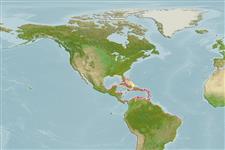Common names from other countries
Environment: milieu / climate zone / depth range / distribution range
Ecologia
; intervalo de profundidade 0 - 1 m (Ref. 83435). Tropical
Western Atlantic: Caribbean to Brazil.
Length at first maturity / Tamanho / Peso / Idade
Maturity: Lm ? range ? - ? cm Max length : 1.8 cm DL macho/indeterminado; (Ref. 83435); common length : 2.5 cm TL macho/indeterminado; (Ref. 344); Idade máx. registada: 2.00 anos (Ref. 8702)
Shell wedge-shaped, inflated. Posterior slope with 2 curved ridges. Surface sculpture consisting of fine radial grooves of microscopic pinpoints. Colour: variable, usually brown, yellowish or purple, with rays of darker hues (Ref. 344).
Assumed total length is 2.5 cm (Ref. 344). Maximum depth from Ref. 104365. Found on beach and shoreline (Ref. 104365). Infaunal in shallow sand, usually in environments rich in particulate organic matter (Ref. 344).
Life cycle and mating behavior
Maturidade | Reprodução | Desova | Ovos | Fecundidade | Larvas
Members of the class Bivalvia are mostly gonochoric, some are protandric hermaphrodites. Life cycle: Embryos develop into free-swimming trocophore larvae, succeeded by the bivalve veliger, resembling a miniature clam.
Leal, J.H. 2003. (Ref. 344)
Status na Lista Vermelha da IUCN (Ref. 130435)
Status no CITES (Ref. 108899)
Not Evaluated
Not Evaluated
Uso pelos humanos
| FishSource |
Ferramentas
Fontes da internet
Estimates based on models
Preferred temperature
(Ref.
115969): 27 - 28.3, mean 27.5 (based on 307 cells).
Resiliência
Elevada, tempo mínimo de duplicação da população menor que 15 meses (K=0.43-1.79; tmax=2).
